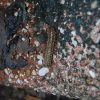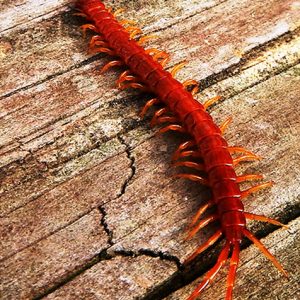calsfoundation@cals.org
Centipedes
Centipedes (class Chilopoda) are myriapods that include two subclasses, five living orders, and about 2,800 described species (out of an estimated worldwide fauna of approximately 8,000 species) within about twenty-three families. Their fossil history dates back over 410 million years ago to the late Silurian Period of the Paleozoic Era. In terms of worldwide geographic distribution, centipedes are found north of the Arctic Circle and inhabit all subarctic regions but are most abundant in temperate, desert, and tropical areas, where they are common terrestrial invertebrates.
Humans have unintentionally introduced several species onto most oceanic islands. However, one order (Craterostigomorpha) is endemic to New Zealand and Tasmania. Members of the families Oryidae and Scutigeridae and of the subfamily Otostigminae have been introduced into North America, and one exotic centipede, Lithobius forficatus, introduced by way of Europe in the 1800s and associated with human disturbance, has now invaded forested areas and likely occurs in Arkansas. Another Palearctic centipede, Cryptops hortensis, has been widely introduced in urban environments (likely from potted plants and greenhouses) and, although not yet reported in Arkansas, is now established in the adjoining states of Louisiana, Mississippi, and Texas as well as sixteen other U.S. states and Canada.
Most of the early records of centipedes in Arkansas were provided by Charles H. Bollman in the late 1800s as well as by renowned myriapodologist Ralph V. Chamberlin in 1931 and 1942–1943. There has never been a complete listing of all the centipedes of the state, although the order Scolopendromorpha has been adequately compiled from various sources.
The smallest centipede is Hoffman’s dwarf centipede (Nannarrup hoffmani), about twelve millimeters (0.5 inches) in length and described from New York City’s Central Park in 2003. The largest centipede in the world is the Amazonian giant centipede (Scolopendra gigantea), described by Carolus Linnaeus in 1758, which occurs in parts of Central and South America and the Caribbean; it can measure up to 275 mm (11.0 inches) long. It preys on a variety of animals, including other large arthropods, amphibians, reptiles, and small mammals, especially bats. In North America, the largest species is the giant red-headed centipede (Scolopendra heros), which can reach lengths up to 200 mm (8.0 inches). In Arkansas, this centipede has been found in at least seventeen counties, primarily in the Interior Highlands of the north and northwestern part of the state, spanning eastward to around Little Rock (Pulaski County).
All centipedes, particularly the large and moderately sized scolopendromorphs and scutigeromorphs, possess “poison claws” and can readily inject venom. Although there are no confirmed human fatalities, some species can inflict painful bites that can result in discoloration, swelling, numbness, and necrosis at the site that may require medical attention. Centipedes should be collected very carefully with long forceps (never with bare hands), as many are flexible and can bend their bodies back 180 degrees and still be able to bite.
Centipedes are exclusively carnivorous, preying mostly on smaller arthropods. Most are fast-moving, agile forms that are adapted for stealth speed. The majority are found under trash piles, rocks, and decomposing wood in microhabitats supported by canopy. One, however—the introduced European house centipede (Scutigera coleoptrata)—is often found in houses with cool, moist sites in bathrooms and basements. In the southeastern United States, including Arkansas, another centipede, Hemiscolopendra marginata, frequently enters homes, garages, and other buildings, and people who pick them up may suffer painful bites.
Little is known about the geographic distribution of most centipedes in Arkansas. However, recent studies have been carried out regarding Scolopendromorpha. These investigations have extended scientific knowledge of their distribution in the state, including records from areas with unique biotic features such as Crowley’s Ridge and what is left of the Grand Prairie. Studies are still lacking on other state groups, such as Geophilomorpha and Lithobiomorpha, as they have never been comprehensively investigated. Interestingly, these are the two centipede orders that are the richest in species: the former includes fourteen component families, 180 genera, and about 1,100 described species, while the latter has ninety-five genera and approximately 1,500 species that have been described to date. Although these might be the most encountered centipedes found under rotting logs, rocks, and debris in the state, there is yet no accounting of how many species within these orders occur in Arkansas. In addition, studies are needed in eastern Arkansas, where habitat for centipedes is shrinking due to extensive agricultural land practices.
There are no endemic species of centipedes in Arkansas, and there appears to be little restriction in ranges of scolopendromorphs, as they occur in nearly all biotic provinces of the state, including the Interior Highlands (Ouachita and Ozark plateaus) and Coastal Plain, although fewer records are available from the latter. Indeed, most authorities regard some of the more common scolopendromorphs—such as Cryptops leucopodus, Scolopocryptops sexspinosus, and Theatops posticus—as statewide in distribution, although this should be viewed with caution until genuine vouchers have been collected from all seventy-five counties of Arkansas. Occasionally, centipedes are reported from cave (karst) systems, and one, Theatops phanus, was described in 1951 by Ralph V. Chamberlin from an unnamed cave in Sutton County, Texas, and since reported from numerous caverns in south-central Texas. To date, there are no published reports of centipedes in the dark zone of caves in Arkansas, although lithobiomorphs have been seen under limestone rocks at cave entrances.
For additional information:
Lewis, John G. E. The Biology of Centipedes. Cambridge: Cambridge University Press, 2005.
Lewis, John G. E., Gregory D. Edgecombe, and Rowland M. Shelley. “A Proposed Standardised Terminology for the External Taxonomic Characters of the Scolopendromorpha (Chilopoda).” Fragmenta Faunistica 48, no. 1 (2005): 1–8.
McAllister, Chris T., Matthew B. Connior, and Henry W. Robison. “New Distributional Records for the Centipede, Scolopendra heros (Chilopoda: Scolopendromorpha: Scolopendridae), in Arkansas.” Texas Journal of Science 62, no. 2 (2010): 157–160.
McAllister, Chris T., Henry W. Robison, Lynne C. Thompson, and Mathew B. Connior. “New Geographic Distribution Records for Centipedes (Chilopoda: Scolopendromorpha) in Arkansas, Including the First from Crowley’s Ridge and the Grand Prairie.” Journal of the Arkansas Academy of Science 66 (2012): 193–196. Online at http://libinfo.uark.edu/aas/issues/2012v66/v66a32.pdf (accessed September 14, 2021).
McAllister, Chris T., Rowland M. Shelley, and James T. McAllister III. “Geographic Distribution Records for Scolopendromorph Centipedes (Arthropoda: Chilopoda) from Arkansas, Oklahoma, and Texas.” Journal of the Arkansas Academy of Science 57 (2003): 111–114. Online at http://libinfo.uark.edu/aas/issues/2003v57/v57a14.pdf (accessed September 14, 2021).
McAllister, Chris T., Rowland M. Shelley, and Henry W. Robison. “Additional Distributional Records for Scolopendromorph Centipedes (Chilopoda) from Arkansas, Kansas, Louisiana, New Mexico, Oklahoma, and Texas, with the First Report of Theatops spinicaudus (Wood) (Cryptopidae) from Texas.” Texas Journal of Science 58, no. 3 (2006): 299–308.
Shelley, Rowland M. “Centipedes and Millipedes with Emphasis on North American Fauna.” Kansas School Naturalist 45, no. 3 (1999): 1–15.
———. “A Synopsis of the North American Centipedes of the Order Scolopendromorpha (Chilopoda).” Virginia Museum of Natural History Memoir no. 5 (2002):1–108.
Walls, Jerry G. The Guide to Owning Millipedes and Centipedes. Neptune City, NJ: T. F. H. Publications, 2000.
Chris T. McAllister
Eastern Oklahoma State College

 Scolopocryptops sexspinosus
Scolopocryptops sexspinosus 



Comments
No comments on this entry yet.